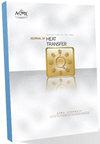Double Diffusive Convective Flow Study of a Hybrid Nanofluid in an Inverted T-shaped Porous Enclosure Under the Influence of Soret and Dufour Prameters
IF 2.8
4区 工程技术
Q2 ENGINEERING, MECHANICAL
引用次数: 2
Abstract
This numerical investigation is dedicated to explore the impact of Soret and Dufour parameters in the double-diffusive convective flow of a hybrid nanofluid in an inverted T-shaped porous enclosure. The thermophysical properties and the numerical values of the hybrid nanofluid are adopted from the experimentally published data. The mathematical model is formulated based on the generalized equation of the Darcy-Brinkmann-Forchheimer model, which is further numerically simulated with the penalty finite element method. As a parametric study, broad values of parameters are considered, including the Rayleigh number, Darcy number, porosity value, buoyancy ratio, Lewis number, Soret, and Dufour parameter. The fluid flow, heat, and mass transfer in the physical domain have been characterized through the results of streamlines, isotherms, and isoconcentration plots, respectively. Additionally, quantitative numerical results for heat and mass transfer rate at the heated(concentrated) wall are expressed through the mean Nusselt and mean Sherwood number at various combinations of flow parameters. The comprehensive study of the present mathematical model reveals that the flow characteristics are directly influenced by the Rayleigh number, Darcy number, porosity value, Lewis numbers, and buoyancy ratio. Moreover, a combined impact of Soret and Dufour parameters is observed in the heat and mass transfer rate.Soret和Dufour参数影响下混合纳米流体在倒t形多孔腔内双扩散对流流动研究
本数值研究旨在探讨Soret和Dufour参数对混合纳米流体在倒t形多孔腔内双扩散对流流动的影响。混合纳米流体的热物理性质和数值采用实验发表的数据。基于Darcy-Brinkmann-Forchheimer模型的广义方程建立了数学模型,并用罚元法对其进行了数值模拟。作为参数研究,考虑了广泛的参数值,包括Rayleigh数、Darcy数、孔隙度值、浮力比、Lewis数、Soret和Dufour参数。通过流线、等温线和等浓度图分别表征了物理领域的流体流动、传热和传质。此外,通过不同流动参数组合下的平均努塞尔数和平均舍伍德数来表示加热(浓缩)壁面传热传质速率的定量数值结果。对现有数学模型的综合研究表明,流体流动特性直接受到瑞利数、达西数、孔隙度、刘易斯数和浮力比的影响。此外,还观察到Soret和Dufour参数对传热传质速率的共同影响。
本文章由计算机程序翻译,如有差异,请以英文原文为准。
求助全文
约1分钟内获得全文
求助全文
来源期刊
自引率
0.00%
发文量
182
审稿时长
4.7 months
期刊介绍:
Topical areas including, but not limited to: Biological heat and mass transfer; Combustion and reactive flows; Conduction; Electronic and photonic cooling; Evaporation, boiling, and condensation; Experimental techniques; Forced convection; Heat exchanger fundamentals; Heat transfer enhancement; Combined heat and mass transfer; Heat transfer in manufacturing; Jets, wakes, and impingement cooling; Melting and solidification; Microscale and nanoscale heat and mass transfer; Natural and mixed convection; Porous media; Radiative heat transfer; Thermal systems; Two-phase flow and heat transfer. Such topical areas may be seen in: Aerospace; The environment; Gas turbines; Biotechnology; Electronic and photonic processes and equipment; Energy systems, Fire and combustion, heat pipes, manufacturing and materials processing, low temperature and arctic region heat transfer; Refrigeration and air conditioning; Homeland security systems; Multi-phase processes; Microscale and nanoscale devices and processes.

 求助内容:
求助内容: 应助结果提醒方式:
应助结果提醒方式:


